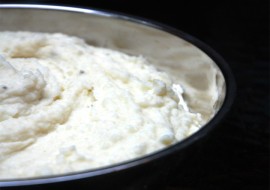Can you feed a family of four for $10 or less a day? Cooks across the county are doing it with careful planning, thinking outside of their daily comfort zones and budgeting—many for the first time. One of my tricks for consistently producing delicious, healthy meals is selecting one affordable main ingredient (today it’s rotisserie chicken), then building three to four meals around it.
Now, are you ready for the best cook’s tip of all? Costco’s three-pound, five-buck birds! Hands down, there is nothing on the market that can beat them for flavor and value. These tasty time savers are moister than any I’ve tried and don’t have added hormones, steroids, preservatives, MSG, glutens, flavors, colors or things that make you glow in the dark. In many instances this ready-to-eat product is close in price to its uncooked counterpart.
A recent trip to the superstore yielded three birds— or nine pounds of roasted chicken – for $15. Compare this to two, two-pound rotisserie chickens that I bought several weeks ago at a local market for $10.99 each—or $21.98. By my calculations, at regular market prices, my Costco birds would have cost $50, which means I saved $35 by shopping smart. What would you do with the bonus bucks? Personally, I vote for a nice bottle of wine or some sinfully dark chocolate cake to finish one of my meals.
With chickens in hand your meal options are unlimited. I try to offer my family a variety of choices based on the season and the weather. If it’s cold and raining outside, a hearty stew or soup offers lots of comfort. Warm sunshine, on the other hand, turns one’s thoughts to crisp salads, tacos and other easy meals that showcase fresh produce.
Day 1: Rotisserie chickens and herb roasted vegetables.
This super easy, elegant meal is ready in 30 minutes. All that’s required is reheating the chicken and chopping some potatoes, carrots, celery, onions and mushrooms for roasting. Put the vegetables on a baking sheet, toss with olive oil, salt and pepper and set them in a preheated 450-degree oven with a couple of sprigs of fresh rosemary and roast for 20 minutes. Halfway through, flip the vegetables over so they’ll crisp on both sides.
Put everything on a platter and decorate with sprigs of deep green Italian parsley for color. Add a basket of warm crusty bread with soft butter and get ready for lots of appreciative oooooh’s and aaahhh’s at the table.
Day 2: Chicken enchiladas with enfrijoladas sauce.
Be different and try a new cuisine. This Mexican classic is quick, easy and great for a crowd or Sunday brunch. All you need is a couple of cups of shredded chicken, corn tortillas and a simple blender sauce of beans, chipotle chiles, bay leaves, browned onions, salt and milk. Whiz, zip and you’re done. Make the enfrijoladas sauce a day or two in advance and let the flavors deepen—assembly is a breeze.
Day 3: Cobb Salad
Bob Cobb, owner of the famous Brown Derby restaurant in Los Angeles, raided the refrigerator for a late night snack in 1937 and found a bevy of treasures: chicken, crisp romaine lettuce, cheese, creamy avocados, crumbled bacon, watercress, tomatoes, chives and hard-cooked eggs. Cobb dressed his salad with French dressing, but I prefer creamy blue cheese.
Pair this complex composed salad with good bread or warm corn muffins and life is good.
Day 4: A hearty homemade soup—you decide.
What are you in the mood for—chicken noodle, Indian mulligatawny or perhaps Mexican tortilla soup? A favorite at my house is chicken-vegetable soup with lots of alphabet pasta thrown in for the kids. Most learned to spell their names eating this soup, while I knew the value of N for nutrition, F for flavor, S for silly fun and C for cheap (we’re talking scraps of chicken, leftover vegetables and homemade stock).
Have you grown feathers yet? If not, know that rotisserie chicken meat makes the best pot pies I’ve ever eaten. Simply combine some chopped meat with cooked potatoes, carrots, and celery in simple cream gravy. Spoon the mixture into pie tins or heat-resistant bowls and top with homemade pie crust for pennies, or best-quality store-bought crust for convenience. Bake to golden flakiness or freeze and bake when you, the cook need some delicious comforting.
Bones, bones, bones—always save the chicken bones for homemade stock. You may think its way too much work; don’t worry. Yesterday, I filled my stockpot with cold water, halved an onion, chopped two carrots and two ribs of celery, and broke apart a bulb of garlic then threw it all into the pot. A handful of whole black peppercorns, two bay leaves, five sprigs of thyme, six whole cloves and three chicken carcasses soon followed. In less than five minutes, stock was on the stove. So, easy and now there are eight four-cup containers of stock in my freezer for stews, soups, gravies, sauces and rice and bean dishes.
Four healthy, flavor-packed meals make me once again ask, how I can be on a budget when it tastes so good.






























